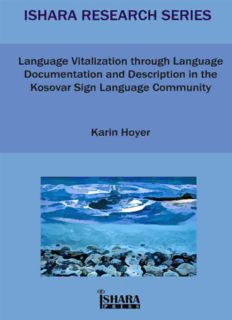Table Of ContentIshara Research Series
The Ishara Research Series is dedicated to current research in sign
language linguistics and Deaf Studies. The series is designed for
publications that are of current relevance to the field, but are not
easily accommodated within the scope of conventional outlets. In
addition, this innovative format is ideal for young researchers and
first-time authors publishing work of high academic quality. The
series is intended to be a tool for stimulating research in emerging
areas, with particular emphasis on promoting Deaf authors and
authors in countries where sign language studies and Deaf Studies
are not established disciplines yet.
Editorial board
Anastasia Bradford
Thierry Haesenne
Peter Hauser
David McKee
Connie De Vos
Language Vitalization through Language
Documentation and Description in the Kosovar Sign
Language Community
Karin Hoyer
Ishara Research Series No. 1 /
Language vitalization through language
Documentation and description in the
Kosovar sign language community /
Karin Hoyer / Nijmegen: Ishara Press 2013.
ISBN 978-90-8656-000-4
Ishara Press
Stichting DEF
Wundtlaan 1
6525 XD Nijmegen
The Netherlands
projectmanager.isharapress@gmail.com
Cover design: Dan Zeshan
E-book first published 2013
Catalogue copy of this book available at
Depot Van Nederlandse Publicaties,
Koninklijke Bibliotheek, Den Haag (www.kb.nl/depot)
Contents
1. Introduction 1
1.1 The structure of the study 5
2. Language endangerment, revitalization
and community empowerment 7
3. The Kosovar sign language community
and KosSL 15
4. Methods and challenges 19
4.1 Language documentation and description
through dictionary work 20
4.2 A participatory approach 23
4.3 The relationship between the language
community and the outside advisor –
attitudes and co-operation 28
4.4 Learning the (local sign) language 33
4.5 Languages used in the SLW – written
language and metalanguage 36
5. Findings and the impact of the project 41
5.1 Raised language awareness 43
5.2 The involvement of the community 48
5.3 Deaf role models as part of sign
language community empowerment 51
5.4 Language documentation and
description – the core of sign language
vitalization and community empowerment 57
5.5 Methods used in Sign Language Work
on a daily basis 66
5.6 Successful sign language training for the
hearing teachers at the Nëna Terezë
deaf school in Prizren 77
6. Sign language vitalization 87
6.1 Vitalizing a sign language 87
6.2 Sign language as a right and as a resource
in the vitalization process 93
7. Conclusions 105
Post Scriptum 114
Appendix 1 116
Appendix 2 124
Appendix 3 125
References 127
Acknowledgements
The work reported here is the result of cooperation with many
actors involved. The staff at the Kosovar Association of the Deaf
were both my colleagues and my guides into a new sign language.
The collaboration with the members in the sign language working
group gave me many insights about Kosovar Sign Language. I am
deeply grateful to all of you Kosovars who made the interviews
and the focus group discussions needed for this study possible:
Nebih Cakaj, Liridon Gashi, Ramadan Gashi, Rukije Gashi, Elma
Hasani, Kimete Haziri, Selman Hoti, Enver Kurtalani, Faton Parduzi,
Drita Toprlak, and the four interviewed teachers at Nëna Terezë
deaf school in Prizren. Nebih and Drita – I have truly enjoyed
working with you. Faleminderit shumë të gjithëve!
Additionally I want to thank Versa Selmani who was my
English-Albanian-English interpreter during the focus group
discussion with the school teachers, and Florjan Rojba, Colin Allen,
Sheena Walters, Susan Emerson, and Arttu Liikamaa for fruitful
collaboration and support during our common years in Kosovo.
Special thanks go to Project co-ordinator Inkeri Lahtinen at the
Finnish Association of the Deaf for all her support and
encouragement during my time in the field. I also wish to thank
Professor Jan-Ola Östman for his insightful supervision, and
Helena Lindell, Gunter Senft and Robert Adam for their comments
on an earlier draft of this paper. The paper has also benefited
from comments by an anonymous reviewer at Ishara Press and
from meticulous proof reading and language checking by Nick
Palfreyman – thank you. I am furthermore grateful to both the
Finnish Cultural Foundation and the Swedish Cultural Foundation
in Finland for their financial support.
Introduction 1
1. Introduction
My experience was – coming from a Deaf1 family – that
all the years in school […] I thought that hearing
people who use spoken language were better than we
Deaf people who had to gesture and sign. We were
Deaf, meaning disabled and inferior. I mean, I had
good communication through signing with Deaf people
but I did not think sign language was proper as a
language. Then I started the sign language research
work here and thought ‘okay, we will work on
documenting signs for teaching purposes’. But then we
were given all this training […], and I was so amazed
about all the things I learned about sign language. I
realized that sign language is important and we are
equal to hearing people. Spoken and signed languages
are similar! And I thought how wrong I had been all
these years, thinking sign language was something
more simple. But it was because I did not know since I
had never had access to this information.
- Nebih Cakaj (Deaf KAD research assistant; my
translation) -
The opening quote above presents insights offered by a Deaf
sign language user involved in a community empowerment
project taking place in the Kosovar sign language community.
The results of the project focus on the importance of the
perspective of language users themselves, their inner
(linguistic) resources, and learning potential.
1 The spelling of ‘Deaf’ with a capital ‘D’ in this paper is a
conventionalized way of referring to non-hearing people as members
of a cultural and linguistic community, rather than defining them in
terms of their audiological status.
Description:Anastasia Bradford. Thierry Haesenne. Peter Hauser by marginalized or low-power language groups, and so on. However, the combination of

